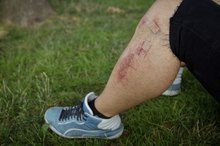Over-the-Counter Treatment for a Staph Infection
Staph, or staphylococcus, is bacteria with more than 30 different types, according to the U.S. National Library of Medicine 1. Staphylococcus aureus is one specific type of staph that causes most staph infections like skin infections, pneumonia, food poisoning, toxic shock syndrome, and blood poisoning 2. Staph is bacteria that live harmlessly on the skin, but when the skin is punctured, the staph bacteria can enter the wound and cause an infection. Staph skin infections are the most common and can be treated over the counter 2.
If you are experiencing serious medical symptoms, seek emergency treatment immediately.
Cleaning
According to KidsHealth.org, localized skin staph infections should first be treated by cleansing with antibacterial soap and then soaked in warm water 2. Antibacterial soaps are sold over the counter and can help limit the spread of staph infections 2.
Antibiotic Ointments
How to Treat Infected Hair Follicles
Learn More
Antibiotic ointments like Neosporin or Polysporin are good topical treatments for staph infections 2. After cleansing skin and then soaking in warm water, dry and apply an antibiotic ointment. Cover the affected area with a clean dressing and to prevent the staph infection from spreading, use towels only once before washing.
Pain Relief
Soaking the area or placing clean, warm wash cloths on the affected area helps relieve pain associated with the staph infection, according to KidsHealth.org 2. Warm water bottles or heating pads can be applied for approximately 20 minutes two to three times per day for pain relief. Take over-the-counter NSAIDs (Tylenol and Ibuprofen) to help control pain associated with a staph infection.
Complications
What Is the Difference Between Cellulitis & Mrsa?
Learn More
If staph infections do not clear up, the bacteria can cause serious complications like toxic shock syndrome, pneumonia and blood poisoning, according to the U.S. National Library of Medicine 12. Additional complications may include cellulitis, a hot swollen red area, or impetigo, a skin crust. If your staph infection does not go away within a few days of treating it with over-the-counter remedies, or you develop a high fever, or the infected area is hot and swollen, seek medical attention immediately.
Prevention
It is important to keep your body and clothes clean, along with bed linens and towels. According to KidsHealth.org, people get staph infections from contaminated objects and through skin-to-skin contact, and it spreads between people who live within close contact to each other 2.
Related Articles
References
- U.S. National Library of Medicine: Staphylococcal Infections
- KidsHealth.org: Staph Infections
- KidsHealth.org: What Can I Do to Feel Better?
- Harris A (Updated January 2019). Patient education: Methicillin-resistant Staphylococcus aureus (MRSA) (Beyond the Basics). Lowy FD, ed. UpToDate. Waltham, MA: UpToDate.
- King JM, Kulhankova K, Stach CS, Vu BG, Salgado-pabón W. Phenotypes and Virulence among Staphylococcus aureus. USA100, USA200, USA300, USA400, and USA600 Clonal Lineages. mSphere. 2016;1(3). doi:10.1128/CMR.00134-14
- Cleveland Clinic. (September 2019). Staph Infection (Staphylococcus Infection)
- Tong SY, Davis JS, Eichenberger E, Holland TL, Fowler VG Jr. Staphylococcus aureus infections: epidemiology, pathophysiology, clinical manifestations, and management. Clin Microbiol Rev. 2015 Jul;28(3):603-61. doi:10.1128/CMR.00134-14
- Sukumaran V, Senanayake S. Bacterial skin and soft tissue infections. Aust Prescr. 2016;39(5):159-163. doi:10.18773/austprescr.2016.058
- Bush L. (Modified June 2019). Merck Manual Consumer Version. Staphylococcus aureus Infections. (Staph Infections)
- De oliveira TH, Amorin AT, Rezende IS, et al. Sepsis induced by Staphylococcus aureus: participation of biomarkers in a murine model. Med Sci Monit. 2015;21:345-55. doi:10.12659/MSM.892528
- Harris A (Updated January 2019). Patient education: Methicillin-resistant Staphylococcus aureus (MRSA) (Beyond the Basics). Lowy FD, ed. Waltham, MA:
- Centers for Disease Control and Prevention. Invasive Methicillin-Resistant Staphylococcus aureus Infections Among Persons Who Inject Drugs. Six Sites, 2005–2016.
- Hassanzadeh P, Hassanzadeh Y, Mardaneh J, Rezai E, Motamedifar M. Isolation of Methicillin-Resistant Staphylococcus aureus (MRSA) from HIV Patients Referring to HIV Referral Center, Shiraz, Iran, 2011-2012. Iran J Med Sci. 2015;40(6):526-30.
- Chu C, Wong MY, Tseng YH, et al. Vascular access infection by Staphylococcus aureus from removed dialysis accesses. Microbiologyopen. 2019;8(8):e00800. doi:10.1002/mbo3.800
- Tong SY, Davis JS, Eichenberger E, Holland TL, Fowler VG Jr. Staphylococcus aureus infections: epidemiology, pathophysiology, clinical manifestations, and management. Clin Microbiol Rev. 2015 Jul;28(3):603-61. doi:10.1128/CMR.00134-14
- Romero-gómez MP, Cendejas-bueno E, García rodriguez J, Mingorance J. Impact of rapid diagnosis of Staphylococcus aureus bacteremia from positive blood cultures on patient management. Eur J Clin Microbiol Infect Dis. 2017;36(12):2469-2473. doi:10.1007/s10096-017-3086-5
- Missiakas DM, Schneewind O. Growth and laboratory maintenance of Staphylococcus aureus. Curr Protoc Microbiol. 2013;Chapter 9:Unit 9C.1. doi: 10.1002/9780471729259.mc09c01s28
- Kobayashi SD, Malachowa N, Deleo FR. Pathogenesis of Staphylococcus aureus abscesses. Am J Pathol. 2015;185(6):1518-27. doi:10.1016/j.ajpath.2014.11.030
- Centers for Disease Control and Prevention. (2019). Deadly Staph Infections Still Threaten the U.S.
- Centers for Disease Control and Prevention. (2011). Staphylococcus aureus in Healthcare Settings.
Writer Bio
William Peterman is a registered nurse with experience in mental health, surgery, urology, drug research and critical care. Peterman holds a Bachelor of Science degree in nursing and also has a Master of Business Administration. His articles on health and nutrition have appeared on various online publications.






